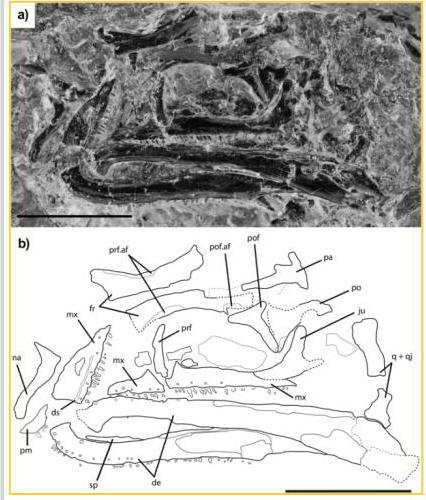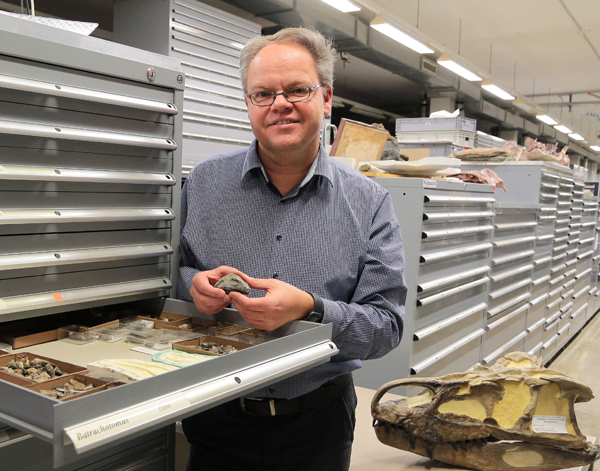Tiny Fossil Sheds Light on Reptile Diversification in the Triassic
Scientists writing in the on-line, open access journal “Scientific Reports”, have published details of a remarkable fossil discovery from a limestone quarry located close to the town of Vellberg in Baden-Württemberg (Germany). The tiny fossilised remains of juvenile lizard-like reptile are helping palaeontologists to better understand the evolution of modern-day lizards and snakes as well as their taxonomic relationship with a “living fossil” – the tuatara of New Zealand.
A Tiny, Partially Articulated Fossil
The partially articulated fossil, including a beautifully preserved skull, is approximately 240 million-years-old (Middle Triassic – Ladinian faunal stage). The entire specimen is around ten centimetres long and it has been named Vellbergia bartholomaei and classified as a stem-lepidosauromorph.
The Tiny Preserved Skull of Vellbergia bartholomaei

Picture credit: Scientific Reports
A Decisive Contribution to a Better Understanding of the Evolution of the Reptilia
The Middle Triassic represents a period in Earth’s history where tetrapod faunas were recovering from the global devastation caused by the end Permian extinction event. However, the paucity of terrestrial vertebrate fossils has limited how much scientists can learn about how the fauna changed and developed during this time, prior to the emergence and eventual dominance of the Dinosauria.
Researchers from the Natural History Museum Stuttgart in collaboration with a colleague from Harvard University (USA), noted that the skeleton of V. bartholomaei showed anatomical traits that link it to both the Order Squamata (lizards and snakes) and the Rhynchocephalia, ancient lizard-like reptiles that includes only one living species, the tuatara (Sphenodon punctatus).
Co-author of the Scientific Paper Dr. Rainer Schoch Holding the Tiny Specimen of Vellbergia bartholomaei

Picture credit: Stuttgart Natural History Museum (Staatliches Museum für Naturkunde Stuttgart)
Vellbergia bartholomaei
Vellbergia is named after the nearby town, whilst the species name honours Alfred Bartholomä of Neuenstein, who was responsible for many of the significant fossil finds associated with rocks of the Middle Triassic age from Germany. The new species described here falls into the smallest size cluster so far collected from the Vellberg location, and likely represents the first juvenile individual from the site. This new taxon depicts a mosaic of features that are generally observed in both early evolving rhynchocephalians and squamates, providing a link between the two and suggesting stem-lepidosauromorphs may have survived up to the Middle Triassic.
The mudstones associated with the limestone quarry have proved to be a particularly successful hunting ground for vertebrate palaeontologists. In 2015, Everything Dinosaur reported upon another discovery made by Dr. Rainer Schoch and his colleagues, the finding of the fossilised remains that provided a fresh insight into the origins of modern turtles (Chelonia).
To read about this fossil discovery: Pappochelys rosinae The Grandfather of all Tortoises and Turtles.
The scientific paper: “A tiny new Middle Triassic stem-lepidosauromorph from Germany: implications for the early evolution of lepidosauromorphs and the Vellberg fauna” by Gabriela Sobral, Tiago R. Simões and Rainer R. Schoch published in Scientific Reports.
The Everything Dinosaur website: Everything Dinosaur.






Leave A Comment